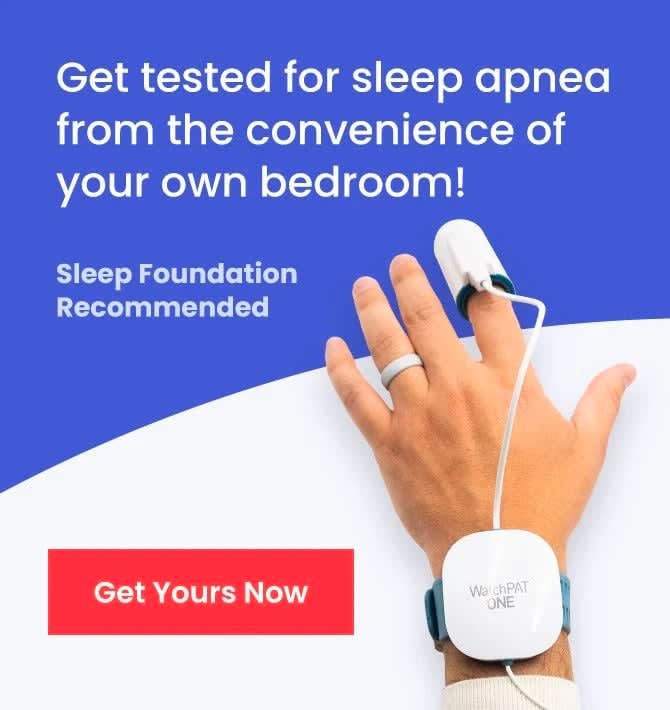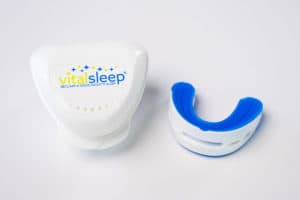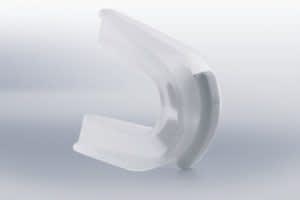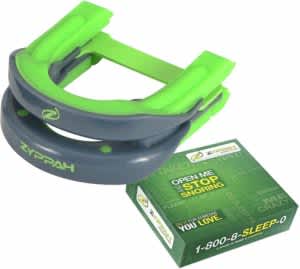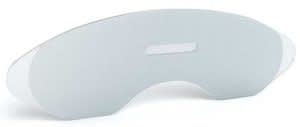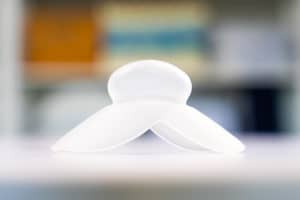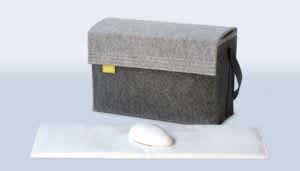When you buy through our links, we may earn a commission. Products or services may be offered by an affiliated entity. Learn more.
Best Anti-Snoring Mouthpieces and Mouthguards
Many people (and their partners) lose sleep due to chronic snoring. According to data from roughly 160,000 Sleep Foundation profiles, more than two-thirds of people snore at least occasionally and 21% snore regularly.
But snorers can often find relief using mouthpieces designed to reduce snoring. These devices, also called mouthguards, reduce snoring by expanding the airway, holding the tongue in place, or, in some cases, both.
Below, you’ll find out expert-back picks for mouthpieces and mouthguards, as well as general information about anti-snoring devices. We discuss different types of anti-snoring mouthpieces and mouthguards, how these devices work, pros and cons of using them, and additional strategies to minimize snoring.
Our Top Picks
-
Best Overall – SnoreRx Plus
View Details
-
Best Value – SmartGuard RX Anti-Snore Device
View Details
Swipe for more
Best Overall
SnoreRx Plus
9.7 /10
Test Lab Score
The SnoreRx mouthguard stands out from other over-the-counter models thanks to its advanced adjustability. The enhanced lateral movement is another perk, since it’s meant to make the mouthguard much less cumbersome than competitors’ versions.

Credit: Sleep Foundation Test Lab
Price
$100
Mouthpiece Type
Mandibular advancement device (MAD)
Full Details
The SnoreRx Plus is an advanced MAD designed for boil-and-bite molding. The affordable sticker price and easy-to-follow instructions make this a good choice for a wide array of people.
Each SnoreRx comes outfitted with a plastic handle that rests between the upper and lower trays. Rather than boiling the device in a pot on your stovetop, bring a cup of water to a boil in your microwave and then place the SnoreRx Plus — fitting handle included — inside the cup. Make sure the entire device is completely submerged for exactly 60 seconds. Next, remove the SnoreRx using the handle and place it directly into a cup of tap water for two seconds. Now, you’ll be ready to bite down onto the device for 30 seconds, pressing both your upper and lower teeth into the mouthguard.
The SnoreRx also offers full lateral adjustment settings. Both sides of the device feature tabs with 1 millimeter measurements up to 6mm, along with an arrow to indicate the current setting. Squeeze the upper tray on both sides to adjust the advancement level, making sure each side is at the same setting. Always remove the device from your mouth before adjusting. According to SnoreRx, most users prefer settings of 3 to 5 millimeters. The company recommends using a given setting for at least three to five nights before adjusting to a new one.
The SnoreRx Plus has a slightly lower price-point than the average MAD. The device comes with a 30-night trial that includes a full refund, minus any shipping charges. SnoreRx offers shipping to the U.S., Canada, Australia, and most European Union countries.
Most Comfortable
Somnofit-S Anti-Snore Mouth Guard+
9.4 /10
Test Lab Score
The customizable and adjustable Somnofit-S is one of the most comfortable anti-snoring devices available. Thanks to its slim profile, wearers can talk and drink water with the mouthpiece in place.

Price
$150
Mouthpiece Type
Mandibular advancement device
Full Details
Learning how to sleep comfortably with an anti-snoring mouthpiece can take some time, but some devices are easier to get used to than others. Take the Somnofit-S, a mandibular advancement device with a slim profile that shouldn’t interfere with speaking or drinking. You can customize the mouthguard using the boil-and-bite method. If needed, you can repeat this process multiple times until the trays are perfectly aligned with your upper and lower teeth.
Each Somnofit-S comes with a set of five durable elastic straps labeled 1 to 5. The numbers signify how tight the straps will fit. If you need to tighten or loosen the mouthguard later on, simply swap in a different strap. The looser straps are effective for overbites, while tighter straps can effectively treat underbites. You should wear each strap for at least three nights before increasing to ensure minimal discomfort, though some jaw pain may still occur.
The Somofit-S comes with a carrying case you can use when traveling or for daytime storage. To clean the device, gently run a toothbrush through the upper and lower trays. Do not use ammonia, bleach, or mouthwash with alcohol for cleaning.
Approachable pricing and a decent lifespan make the Somnofit-S a high-value option for shoppers. Ground shipping is also free if you purchase the device through Sleep Doctor. You may return it unopened for a refund within 60 days of the delivery date.
Best Value
SmartGuard RX Anti-Snore Device
The SmartGuard Rx Anti-Snore Device performs at the same level as many competing MADs, but its sticker price falls well below average. An adjustable design with upper and lower trays helps you sleep comfortably and curb heavy snoring.
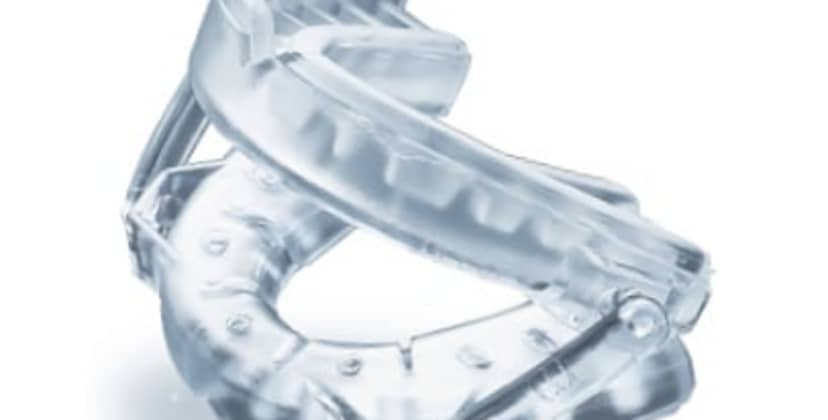
Price
$50
Mouthpiece Type
Mandibular advancement device
Full Details
When using an MAD, a proper fit is crucial not only for reducing your snoring but also ensuring a comfortable night’s sleep. The SmartGuard RX Anti-Snoring Device has an adjustment range of 6mm, allowing you to advance or recede 3 millimeters in either direction. The moldable trays also feature two wings, which you can squeeze together if you have a widely arched mouth or pull apart if your mouth is narrowly arched.
The Anti-Snoring Device is a boil-and-bite apparatus, so you can create a personalized mold at home using hot and cold water. Detailed instructions for customizing the device come with your order. You don’t need a prescription to purchase this mouthpiece, and it’s FDA-cleared for adults 18 and older who snore. If you’re experiencing symptoms of obstructive sleep apnea, consult your doctor before using the device.
The Anti-Snoring Device is affordably priced compared to competing mouthpieces, and Sleep Doctor backs each purchase with a 60-night trial.
Best Mouthpiece for Sleep Apnea
Apnea Sciences ApneaRx Sleep Apnea Mouthpiece
8.7 /10
Test Lab Score
Custom-fitted and adjustable with 10 different settings, the ApneaRx Sleep Apnea Mouthpiece is designed to fit comfortably inside most people’s mouths. A simple boil-and-bite kit lets you make the impression in the comfort of your own home.
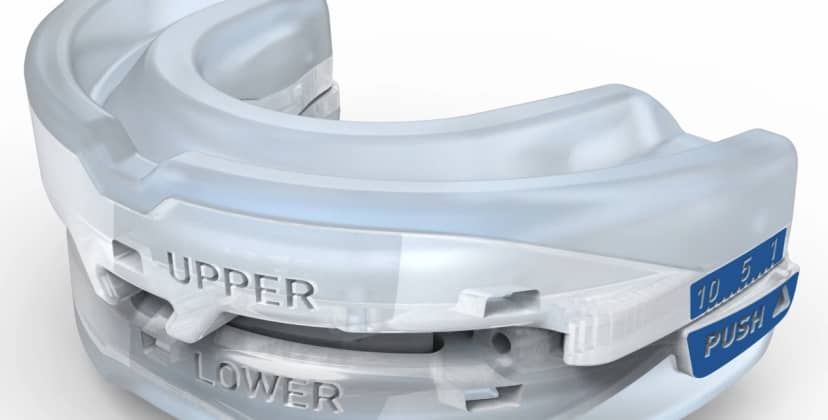
Price
$199
Mouthpiece Type
Mandibular advancement device
Full Details
Getting used to sleeping with anti-snoring mouthpiece can take some time, especially if you’re prone to jaw pain or soreness. The ApneaRx Sleep Apnea Mouthpiece is more comfortable than a lot of competing MADs thanks to its personalized design. Not only is the appliance custom-fitted to your mouth, but it can also be adjusted in 1-millimeter increments up to 10 millimeters. This helps you acclimate to wearing the device at night, and allows you to make slight tweaks to keep jaw pain at bay.
You’ll receive a kit in the mail with a boil-and-bite molding tray and detailed instructions for creating your customized impression. Once the mold has been successfully produced, you’ll send it to the company’s design lab, where a technician will craft a mouthpiece based on the unique dimensions of your mouth and jaw. The device may be a more comfortable alternative to traditional CPAP therapy for people with OSA. However, those with dental problems, TMJ, and TMD should avoid this device.
While the ApneaRx is on the expensive side, the appliance may be reimbursable through private insurance. Contact your provider if you aren’t sure whether your plan will cover the cost. Sleep Doctor offers free ground shipping within the contiguous U.S., and you may return the impression kit within 60 days of delivery as long as it hasn’t been used or removed from its packaging.
Best for Back Sleepers
Airway Management myTAP Oral Appliance
8.7 /10
Test Lab Score
One of the most adjustable MADs on the market, the myTAP Oral Appliance offers a wide range of settings for both lower jaw advancement and vertical opening. You can create a customized impression at home within 15 minutes — no lab necessary — and the device can be easily remolded whenever a tweak is needed.
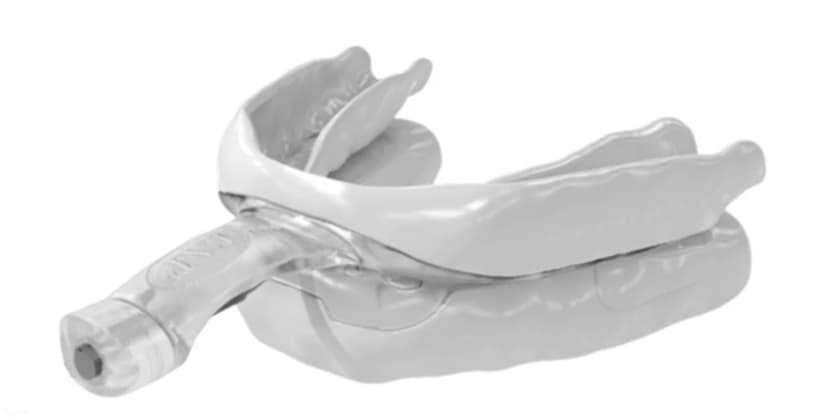
Price
$199
Mouthpiece Type
Mandibular advancement device (MAD)
Full Details
People with OSA and others who snore heavily often struggle with back sleeping, as this position can cause the head to fall too far back and restrict airflow in the breathing passages. The myTAP Oral Appliance from Airway Management mitigates this issue with a slim, low-profile design that holds the lower jaw in place and promotes steady circulation. You can adjust the advancement level up to 22 millimeters for optimal comfort, and additional shims can be purchased to raise the upper tray as much as 12 millimeters from the bottom tray.
Reusability is a notable advantage of the myTAP Oral Appliance. Using a simple boil-and-bite method, you can customize both trays to fit the unique dimensions of your mouth, teeth, and jaw. Simply apply heat to soften the mold in the upper and lower trays whenever you need to make another impression. As a result, the device should perform much longer than the average MAD.
While the myTAP is on the expensive side, the reusable design should extend the device’s lifespan and this may be worth the investment. Customers who order through Sleep Doctor and reside in the contiguous U.S. also receive free shipping with their purchase. The impression kit may be returned unused and unopened within 60 days of the delivery date.
Best Tongue Stabilization Device
Zyppah Anti-Snoring Mouthpiece
The Zyppah Anti-Snoring Mouthpiece is a great option for anyone who hasn’t seen snoring improvements from a traditional MAD. The device both retains your tongue and advances the lower jaw up to 2 millimeters forward to reduce snoring in two different — and effective — ways.

Price
$130
Mouthpiece Type
MAD/TRD hybrid
Full Details
If you haven’t successfully reduced your snoring with a mandibular advancement device, a hybrid anti-snoring mouthpiece might produce better results. The Zyppah is a prime example. This device holds your tongue in place and advances your lower jaw forward to help your breathing passages reach maximum airflow potential.
Thanks to its boil-and-bite design, you can customize the Zyppah for your teeth at home. You can repeat this process as many times as needed if customization doesn’t work the first time. The lower jaw can advance up to 2 millimeters forward, while a thin strap holds your tongue in place. This extra airflow means you might be able to sleep comfortably on your back.
Daily cleaning is important. Wash the mouthpiece with water or alcohol-based mouthwash, but don’t soak it, as this can damage the hardware and void your warranty. A storage container that doubles as a travel case is included with each purchase.
Roughly 70% of owners report their Zyppah is effective beginning on the first night, but you may need a few nights to adjust to the mouthpiece. Your order comes with a 91-night trial period to ensure plenty of time for deciding whether or not the Zyppah is effective. Sleep Doctor offers free ground shipping for customers in the contiguous U.S.
Best Mouthpiece Sterilization Device
Zima Dental Pod
The Zima Dental Pod is equipped with ultrasonic technology to thoroughly rinse and sterilize your anti-snoring mouthpiece and keep it hygienic night after night. In addition to MADs and TRDs, you can use the Pod with clear aligners, retainers, and dentures.
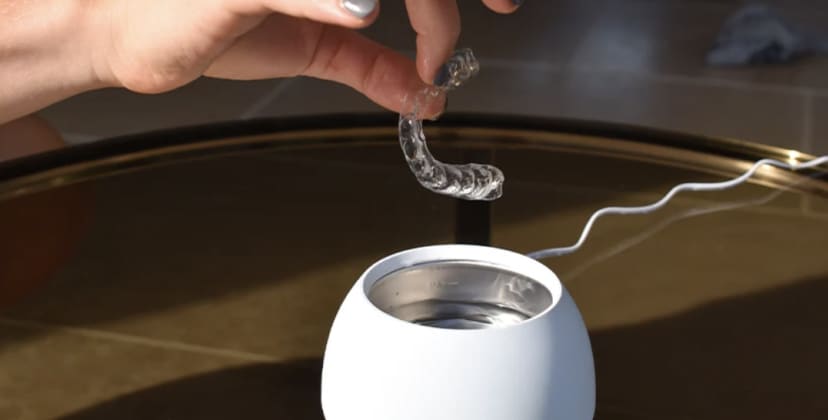
Price
$100
Mouthpiece Type
Mouthpiece cleaning device
Full Details
Keeping your anti-snoring mouthpiece clean is crucial to your oral hygiene and overall health, but scrubbing the device on a daily basis can be a chore. The Zima Dental Pod is a convenient workaround. Simply place your mouthpiece inside the Pod, fill it with water, insert a sterilizing tablet, and press a button. Your device will be thoroughly cleaned and ready to use in a matter of minutes.
The Zima Dental Pod uses ultrasonic technology to generate microscopic bubbles, which expand and collapse around the mouthpiece roughly 4,000 times per second — this is known as cavitation. By thoroughly cleaning every nook and cranny of your oral device, the Pod leaves it completely sterilized and ready to use. From start to finish, the process takes about 5 minutes. The Pod will automatically shut off when the cleaning is complete. Be sure to rinse the mouthpiece under clean water after removing it from the Pod.
If you use an anti-snoring mouthpiece nightly, the Zima Dental Pod may prove to be a worthwhile investment, especially at such an approachable price point. Sleep Doctor also offers free shipping within the contiguous U.S. and a 60-night return period.
Best Overall
SnoreRx Plus
Advanced customization options makes this mouthpiece suitable for a wide range of sleepers.
See More Details

Credit: Sleep Foundation Test Lab
Most Comfortable
Somnofit-S Anti-Snore Mouth Guard+
A slim profile and customizable design ensure comfort for snorers who use this mouthpiece.
See More Details

Best Value
SmartGuard RX Anti-Snore Device
Easy customization, advanced titration, and an approachable sticker price set this MAD apart from many competing mouthpieces.
See More Details

Best Mouthpiece for Sleep Apnea
Apnea Sciences ApneaRx Sleep Apnea Mouthpiece
A custom-fitted prescription mouthpiece you can later adjust as needed for the most comfortable fit.
See More Details

Best for Back Sleepers
Airway Management myTAP Oral Appliance
A sturdy design that keeps your airway open in any sleep position, including when on your back.
See More Details

Best Tongue Stabilization Device
Zyppah Anti-Snoring Mouthpiece
A standout hybrid mouthpiece that acts as an MAD and a TRD to maximize your airflow.
See More Details

Best Mouthpiece Sterilization Device
Zima Dental Pod
An advanced cleaning solution that uses ultrasonic technology to thoroughly sterilize your anti-snoring mouthpiece.
See More Details
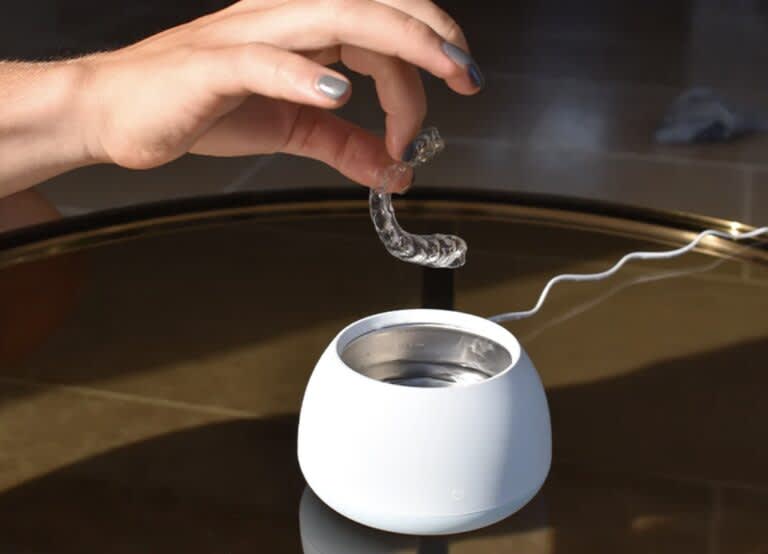
Best Anti-Snoring Mouthguards Video
Watch the video below to learn more about our top picks for anti-snoring mouthguards.
Why You Can Trust Us
Our testing team is made up of sleep product experts, each with years of experience researching and evaluating various products. We tested more than a dozen anti-snoring mouthpieces and mouthguards before selecting the top picks listed above. These include both mandibular advancement devices (MADs) and tongue-retaining devices (TRDs).
How We Tested These Mouthpieces
The evaluation process involved testers sleeping with each mouthpiece in place for at least one night. We focused on assessments from testers who occasionally or frequently snore. Those who don’t usually snore provided more general feedback about qualities such as ease of customization and overall comfort. These top picks reflect the collective findings of our testing team.
Who Should Consider an Anti-Snoring Mouthpiece?
There’s no cure for snoring, but a quality oral appliance should significantly reduce symptoms. Snoring usually occurs due to a restricted airflow through the breathing passages. This can happen for different reasons.
- If your soft palate is relatively thick or hangs somewhat low, then your airway will be narrower and snoring is more likely.
- Chronic congestion and other nasal problems may also cause snoring.
- Having overweight or obesity can cause extra tissue to accumulate around the airway, as well.
- If you drink alcohol before going to sleep, your throat may relax a bit too much. This can cause the tongue to fall back into your throat, blocking the airway.
- The throat muscles may also relax if you’re excessively tired or sleep deprived.
- Sleeping on your back leaves you most vulnerable to snoring because the tongue is more likely to block the airway.
For those with snoring issues unrelated to sleep apnea, MAD and TRD mouthpieces can decrease snoring episodes on a nightly basis. These devices are much more affordable and and less invasive and risky than upper airway surgery and other medical procedures used to treat snoring. Be sure to speak to your doctor before purchasing an MAD or a TRD or trying one for the first time.
While effective for many, you may find that anti-snoring mouthpieces and mouthguards aren’t right for you. Some people find these devices uncomfortable or even painful at times. They may also be ineffective at treating heavy snoring from conditions like obstructive sleep apnea.
How Do Anti-Snoring Mouthpieces Work?
Despite their effectiveness against snoring for many, anti-snoring mouthpieces are fairly simple devices with a small number of individual parts. How they work depends on whether the mouthpiece is an MAD or a TRD.
Mandibular Advancement Device (MAD)
MADs are the most common type of anti-snoring mouthpiece. Most have thermoplastic material in the upper and lower trays where your teeth are intended to fit. When exposed to boiling water, the thermoplastic will soften and you’ll be able to bite down into both trays, creating a customized mold. Unless the device’s instructions say otherwise, the step-by-step, boil-and-bite process is as follows.
- Before boiling, try on the mouthpiece by softly biting down onto the thermoplastic in the upper and lower trays. A properly fitting device should come within a couple millimeters of your lips.
- For some devices, you may need to trim the ends of the upper and lower trays in order for the device to properly fit. For others, this step won’t be necessary.
- Boil water in a pot on your stovetop or in a microwaved cup (depending on what the directions say). Once the water has boiled, place the water’s container on a non-heated surface. Make sure there’s enough water in the container to completely submerge the mouthpiece.
- Submerge the mouthpiece in the boiled water for 30 to 60 seconds, depending on the directions.
- At this point, you may need to place the mouthpiece in cold water for a couple of seconds. Most models will be ready for molding, though you should let the thermoplastic cool off for a moment before biting into it.
- After placing the device in your mouth, bite down firmly with your upper and lower teeth. The thermoplastic should feel warm but not excessively hot; if the latter, allow it to cool a bit longer. Make sure your tongue is pressing against the roof of your mouth as you do so. This helps to dry off the mouthpiece.
- If your first mold is unsuccessful, repeat these steps. The thermoplastic should soften enough to allow multiple attempts.
Assuming the mold is successful, the MAD will advance your jaw by at least 1 millimeter once it’s placed inside the mouth with your teeth in the upper and lower trays. Customizable models can be manually adjusted in increments of 1 millimeter to ensure a comfortable advancement level. Other MAD models automatically adjust using a flexible hinge that adapts to the shape of your jaw and mouth. By advancing the jaw forward, MADs can widen your breathing passages to allow easier air passage and reduce the risk of snoring.
Tongue-Retaining Device (TRDs)
TRDs are a bit more straightforward. Most TRDs resemble the pacifiers used by babies and infants. They are outfitted with flanges that rest against the inner folds of your upper and lower lip, along with an opening where the tongue fits. This opening is fairly narrow to promote suction, which keeps the tongue near the front of the mouth and away from the back of your throat. TRDs are normally designed for universal fit, so you won’t need to follow boil-and-bite instructions or customize their settings.
Pros and Cons of MADs vs. TRDs
MADs and TRDs both have the potential to reduce snoring episodes for sleepers. However, each device carries different advantages and disadvantages for sleepers.
| Device Type | Pros | Cons |
|---|---|---|
| Mandibular Advancement Device (MAD) |
|
|
| Tongue-Retaining Device (TRDs) |
|
|
How Do You Choose an Anti-Snoring Mouthpiece or Mouthguard?
MADs and TRDs achieve the same outcome — less snoring, in most cases — using completely different means and mechanisms. As you determine which type of anti-snoring mouthpiece will work best, consider the following factors.
- Customization: MADs offer more customization options. Most of these mouthpieces are boil-and-bite models with trays containing thermoplastic, allowing you to create a custom mold for your teeth. TRDs don’t require or offer this level of customization. Most are universal fit designs, but some models come in multiple sizes to accommodate different sleepers.
- Quality Material: Most MADs and TRDs are made from silicone resin, plastic, or a combination of both of these materials. Boil-and-bite MADs may be made entirely of moldable thermoplastic or just contain layers of this material in their upper and lower trays. Most anti-snoring mouthpieces made today don’t contain latex or BPA plastic. Most devices will last between six months and two years before a replacement is needed.
- Comfort: Some sleepers prefer the jaw-advancing feel of a MAD over the tongue-retaining suction of a TRD. For others, the opposite is true. You may want to consider both in order to determine which device is more comfortable. If you do, models with sleep trials are probably the best bet. The bottom line: Ask your doctor about MADs and TRDs to learn about your best options, then go from there.
- Adjustability: With some MADs, you’ll be able to adjust how far the device advances your jaw. These devices can usually be adjusted in 1-millimeter increments. Alternatively, the other MADs cannot be manually adjusted. These devices often feature hinge mechanisms that automatically adjust to the users mouth. TRDs, by design, cannot be adjusted.
- Ease of Cleaning: For best results, we recommend rinsing your anti-snoring mouthpiece in hot water after each use. If you use a MAD, you should regularly scrub the upper and lower trays to prevent bacterial buildup. Some brands offer proprietary cleaning solutions for their MADs. Toothpaste and a toothbrush may also work. If you use a TRD, be sure to clean the interior of the tongue opening. Many anti-snoring mouthpieces come with protective cases; if not, make sure the device is stored in a clean environment when not in use.
- Prescription Requirements: Many anti-snoring mouthpieces are available over the counter. For some devices, you’ll need approval from your doctor or dentist and a prescription. Most prescription anti-snoring appliances are MADs custom-fitted for your upper and lower teeth using dental impressions. You’ll obtain the device through your dentist, and visit for routine checkups to ensure the mouthpiece fits and works properly.
How Much Do Anti-Snoring Mouthguards Cost?
Anti-snoring mouthpieces typically cost between $50 and $150. MADs are a bit more expensive, with an average price range of $75 to $150. Most TRDs cost $100 or less. Free shipping may or may not be available, depending on the manufacturer’s delivery policy, but full refunds are usually granted if returns are allowed. Some brands also offer their mouthguards at a discounted rate if you purchase two or more at once.
The price range of $50 to $150 might sound expensive for a device that will, in all likelihood, need to be replaced within two years. However, anti-snoring mouthpieces cost much less than upper airway surgery and other medical procedures intended to treat snoring symptoms.
What Are Other Snoring Solutions?
MAD and TRD mouthpieces can be very effective for some sleepers, but these devices may not be right for you, especially if you experience severe chronic snoring. Other treatment options for snoring include the following:
PAP Therapy
Sleep apnea is a condition characterized by temporary loss of breath during the night, as well as heavy snoring. For people with sleep apnea, positive air pressure (PAP) therapy can reduce the frequency and severity of their nighttime episodes. This therapy involves a machine that draws in outside air using a fan, humidifies and pressurizes the air, and then delivers it to the user through a connective hose and a face mask that covers the mouth and/or nostrils. There are three common types of PAP therapy.
- During continuous positive air pressure (CPAP) therapy, the machine delivers air to its user at one prescribed pressure rate.
- For bi-level positive air pressure (BiPAP) therapy, the pressure toggles between a lower rate for inhalation and a higher rate for exhalation, which can make breathing easier for some people.
- Unlike the other two, automatic positive air pressure (APAP) doesn’t follow a fixed pressure schedule. Instead, the machine adjusts pressure levels based on the user’s breathing patterns.
PAP therapy machines, humidifiers, and face masks all require a doctor’s prescription. Consult your physician to learn more if you experience sleep apnea symptoms.
Pillow Loft and Adjustable Beds
Back sleepers are more susceptible to snoring than those who use other sleep positions because the tongue is likely to fall into the back of the throat and block the airway. For some back sleepers, more pillow loft (or thickness) is needed to elevate the head and keep the tongue closer to the front of the mouth. If your head tends to fall too far back on your pillow, then you should consider a thicker pillow or a different sleep position.
Adjustable beds can also be beneficial to snoring back sleepers. These beds can be raised or lowered at the head and foot, allowing you to sleep with your head elevated while the rest of your body lies flush with the bed. The downside: Adjustable beds can be quite expensive.
Lifestyle Adjustments
You may experience less snoring by changing your daily and nightly routines. Losing weight can reduce snoring by a significant extent, as having overweight or obesity are major risk factors. Quitting smoking and cutting down on alcohol consumption — especially before bedtime — can also help reduce snoring.
If you experience chronic snoring and normally sleep on your back, then you should consider sleeping on your side. The tongue is less likely to fall into the back of the throat while you’re lying on your side. You can also prevent airway blockage by sleeping on your stomach, but this position is associated with more aches and pains and is generally discouraged.
Lastly, the trick to less snoring might be getting more sleep. If you go to bed feeling sleep deprived, the muscles around your throat will relax more during the night and the potential for airway blockage will be much higher. Most adults should sleep at least seven to nine hours each night, including on the weekends.
Surgery
Serious snoring may necessitate a surgical procedure. Several procedures can be used to mitigate snoring symptoms. These include
- Uvulopalatopharyngoplasty involves removing tissue from the back of your throat to broaden the airway.
- Radiofrequency tissue ablation involves a low-intensity signal that decreases tissue around the palate, throat, and tongue.
- Maxillomandibular advancement surgery permanently moves the upper and lower jaws.
- Hypoglossal nerve stimulation reprograms the nerves that control your tongue’s movements in order to prevent airway blockage.
Surgery can be very expensive, even with health insurance. You should consider any of these procedures as a last resort for snoring treatment.
Dive Deeper: In-Depth Anti-Snoring Mouthpiece Reviews
For a closer look at some of the anti-snoring mouthpieces listed in this guide as well as other snoring solutions, check out our in-depth product reviews below.
Frequently Asked Questions
Are anti-snoring mouthguards safe?
Anti-snoring mouthguards are generally considered safe, but you should always consult your doctor before trying one for the first time. Because they physically advance the jaw forward, MADs can lead to and/or exacerbate temporomandibular joint (TMJ) disorder, which is characterized by pain in the jaw and its surrounding muscles. MADs and TRDs may also cause pain and irritation to the teeth and gums, especially if the device is not custom molded.
Before purchasing a device, carefully research the top models on your list to see if there have been any known defects or safety issues associated with those products. You can also reach out to customer service personnel to inquire about potential safety concerns.
How important is certification and what should I look for?
Under the U.S. Food and Drug Administration (FDA), MADs, TRDs, and other “intraoral devices for snoring and/or sleep apnea” are considered Class II medical devices. This means they present some risk to users because they come in direct contact with the body. As such, the FDA regulates the sale and distribution of these devices. Mouthpieces must be thoroughly tested and proven to be effective before the FDA will clear them for sale. Any device you buy should carry a “cleared by FDA” label.
Do I need a prescription for an anti-snoring mouthpiece?
Most anti-snoring mouthpieces can be sold over the counter and don’t require a prescription. However, you’ll need a prescription for certain MADs and TRDs, as well as some advanced custom mouthpieces. Prescription requirements, if any, will typically be listed on the online product pages for these devices.
Can I wear it with dentures?
If you wear dentures, you should avoid using MAD mouthguards. These devices physically move the jaw forward. In doing so, they can interfere with dentures — and in some cases, dislodge them. MADs aren’t recommended for people who have dental implants or loose teeth, either. TRDs, on the other hand, don’t mold to the teeth and are perfectly denture-friendly (though you should first check with your doctor to make sure these devices are right for you).
Do mouthguards prevent bruxism (teeth grinding)?
MADs can prevent, or at least minimize, nighttime teeth grinding. These devices have upper and lower trays to hold and separate the teeth. Assuming the device is properly fitted, it will keep your upper and lower teeth in place and prevent them from coming into contact with one another. TRDs do not separate the teeth, and there’s no evidence they reduce nighttime teeth grinding.
How do I clean my mouthpiece?
Cleaning instructions vary by model, but you’ll want to sterilize the mouthpiece with hot water after each use. Regularly scrub the device with a cleaning solution to prevent bacterial buildup. You’ll also want to store the mouthpiece in your bathroom cabinet or another relatively cool place where it won’t be exposed to excessive heat or moisture. Many MAD and TRD manufacturers offer a protective case for their devices.
Do mouthguard manufacturers offer returns? What about warranties?
Anti-snoring mouthpieces often come with a sleep trial of 30 to 60 nights. This allows you to use the device for at least one month before deciding whether to keep it or return it for a refund. Shipping charges are usually non-refundable.
Warranties are less common, but some MAD and TRD models are backed by some sort of manufacturer’s guarantee. In most cases, the warranty will cover the device for up to one year.

Still have questions? Ask our community!
Join our Sleep Care Community — a trusted hub of product specialists, sleep health professionals, and people just like you. Whether you’re searching for the perfect mattress or need expert sleep advice, we’ve got you covered. Get personalized guidance from the experts who know sleep best.



